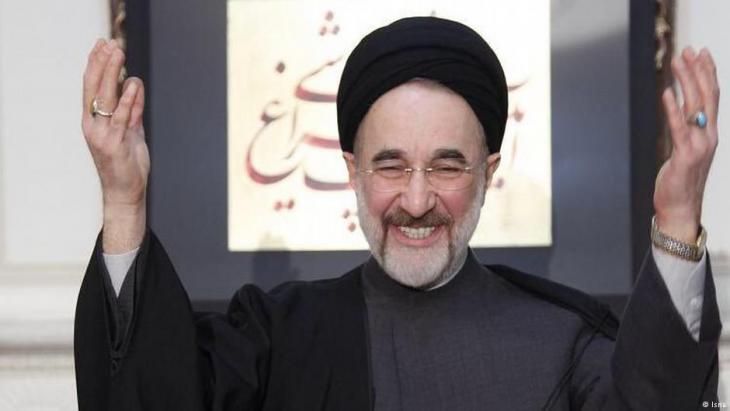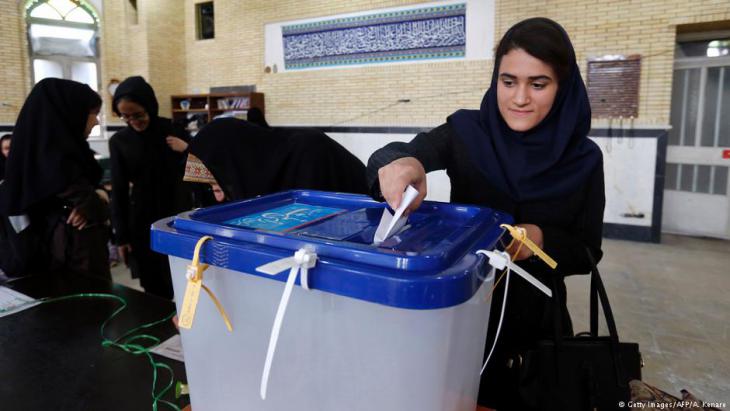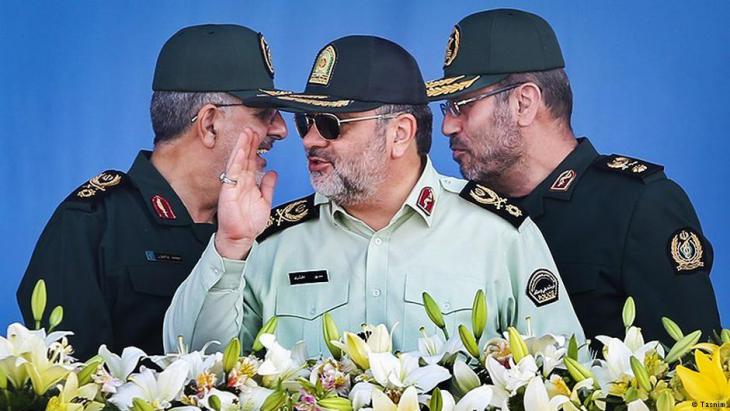Making believe

Commentaries and analyses in the European media often give the impression that there have been fundamental political changes in Iran since Rouhani took office. This is a misconception, however, because what has actually happened is nothing more than a change in leadership within a systemic continuity. In spite of the competition that admittedly exists between the different political camps within the exclusively Islamist spectrum of Iran's political elite, the country's political and economic system has proven astonishingly resistant to reform.
The common argument that the West has a responsibility to institute policies designed to strengthen the so-called "moderate camp" (Hassan Rouhani, former President Mohammad Khatami) against the more "radical" elements ignores the fact that both political elites are actually in the same boat.
No possibility for real political participation
The spectrum of the Islamist elite in the Islamic Republic ranges from reformists to conservatives and onward to fundamentalists and extremists. While the former actually do complain of certain restrictions on political liberties and advocate for the compatibility of Islam and democracy, the political forces that might be called "religious reformers" can hardly be viewed as champions of democracy and human rights.
Although the "religious reformers" support a more tolerant Islam, their assertion of its compatibility with democracy and human rights has yet to be consistently demonstrated in practice. Rather, a kind of majority rule is endorsed in many cases, in which religious minorities and non-believers have little chance at political participation.

The European media has also failed for the most part to subject Hassan Rouhani's economic policy agenda to a thorough examination. Most economic analyses shed light on only one side of the coin – namely, the supposedly manifold potential and incentives for European companies in Iran. Many have argued that Iran's economy has recovered under Rouhani.
The flip side of the coin, however – and little is heard of this in most European media – is that political and economic power in Iran still lies mainly in the hands of unelected state and semi-state entities.Moreover, as we have already seen in so many other countries, a commitment to neoliberalism is utterly unsuitable as a means for overcoming socio-economic problems like those facing Iran. President Rouhani's economic "reform course" has thus failed to facilitate sustainable and socially responsible economic development. Since he took office, relative poverty and income inequality have in fact risen.
Iran – a "regulated democracy"?
Under Rouhani's presidency, the political system in Iran has often been referred to as practically a "semi-democracy", or a "regulated democracy", etc., a claim that lacks any basis in reality and can be seen more as a self-definition propagated by some of the regime elites.
Analyses of Iran's political system often cite the parallel existence of a republican and a theocratic pillar. According to this view, the republican pillar manifests itself in the direct election of the president and the parliament, whereas the theocratic pillar comprises the other institutions, including the Supreme Leader. The problem with this model is that the republican pillar is actually not one at all, as neither the president nor the members of parliament are really elected in free and democratic elections because all the candidates are first vetted for their loyalty to the regime by the Guardian Council.

Elections in Iran thus tend to ensure the continuation of the regime within the limits it itself has defined. Nevertheless, the unpredictable results do lead to some policy changes and redistributions of power within the political elite. It would thus be more logical to see the Islamic Republic of Iran as a variant of so-called electoral authoritarianism. And yet, regardless of political practice in Iran, we already know that elections do not per se provide proof of the existence of democracy. Democracy also entails political freedoms that are largely absent in the Islamic Republic.
Iran's stability stands on feet of clay
The hypothesis has also continually been put forth that Iran is the only stable country in the region – unlike other states that have been swept up in the "Arab Spring". This assumption fails to recognise, however, that the country's apparent state of stability, on closer examination, is standing on feet of clay. This was compellingly demonstrated most recently by the uprising at the turn of the year. The fact is that there exists in Iran today, similar to other countries in West Asia and North Africa, a mixture of socio-economic malaise and political immaturity on the part of the majority of the population, offering fertile ground for future uprisings against the regime.The dark side innate to the political system in the Islamic Republic is thus consistently ignored: namely, that the domination of the elites continues unabated, systematically shutting out the vast majority of the population from political and economic participation.
We therefore must conclude that the situation in the Islamic Republic of Iran – despite claims to the contrary from both the state itself and abroad – much resembles that in the neighbouring countries of the "Arab Spring". The Iranian system's resistance to reform as mentioned above narrows down the country's possible democratisation options, as found in a recent comparative study by the sociologist Misagh Parsa. Gradual institutional reforms will not be sufficient for real change.
Reformers caught in the system's wake
Against this backdrop, the assertion constantly repeated for years by many Iran analysts and European media-makers that the only viable route to democratisation in the country is through step-by-step reforms can be seen as nothing but an echo of the views of the reformist wing of the Islamic Republic's own political elite, which is more interested in moderate modification of the system than in any real change.

Iran's foreign policy
And yet it would also be misguided not to recognise any changes at all in Iranian policy. We must in fact acknowledge that President Rouhani and his foreign minister Javad Zarif, who is highly respected in international diplomatic circles, have pursued a different language when dealing with the West.
The successful conclusion of the nuclear deal can be seen as a success of that new tendency. However, there are still continuities in foreign policy that receive too little attention. Because the truth is that neither the government nor the foreign ministry have any real authority over foreign policy. The charge that they serve merely as a PR machine thus appears to be not completely out of hand. Iranian policy towards Iraq and Syria is still primarily determined by the Revolutionary Guards and the head of state, Ayatollah Ali Khamenei, who are interested less in a balance of power than in retaining and expanding Iranian regional power.
One of the central analytical errors made by observers is thus to equate one-to-one the conciliatory foreign policy proclaimed by the government and the foreign minister with Iran's power politics in Iraq and Syria. While such a projection has been adopted uncritically by some European media and political circles, with the long-term goal of a strategic political rapprochement with the regional power Iran, many neighbouring countries fail to comprehend this attitude and see it as the expression of clear favouritism toward Iran.
Ali Fathollah-Nejad
© Qantara.de 2018
Translated from the German by Jennifer Taylor
Dr. Ali Fathollah-Nejad is a Visiting Fellow at the Brookings Doha Center; Iran expert for the German Council on Foreign Relations (DGAP) and at the Belfer Center of the Harvard Kennedy School.
This is an abridged and slightly updated version of a longer analysis, published in the Konrad Adenauer Stiftung's Iran Reader 2017 under the German title "Kritik der Iran-Analysen unter Präsident Rohani: Von Dämonisierung zu Glorifizierung".
